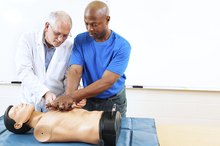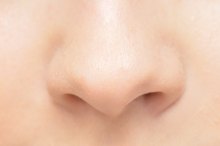Side Effects of Being Intubated
Endotracheal intubation -- a medical procedure that involves the placement of a tube into the trachea, or windpipe, to help unconscious or medically compromised people breathe -- may cause side effects 2. These may be mild, such as temporary sore throat, or as serious as a collapsed lung.
Swelling
Repeated attempts to place the intubation tube within the trachea can damage the surrounding tissues within the mouth or throat. Inflammation caused by tissue damage can result in swelling of the injured body region, a side effect of intubation, referred to as edema. Upon waking, a person who has been intubated can experience a sore throat, difficulty swallowing or discomfort within swollen regions of the face or neck. These side effects of being intubated are temporary and typically subside after removal of the intubation tube 3.
- Repeated attempts to place the intubation tube within the trachea can damage the surrounding tissues within the mouth or throat.
- Upon waking, a person who has been intubated can experience a sore throat, difficulty swallowing or discomfort within swollen regions of the face or neck.
Aspiration
What Are the Adverse Side Effects of Magnesium Citrate?
Learn More
People who are conscious when intubated can experience gastric aspiration as a side effect of this procedure. Placement of the intubation tube can induce your gag reflex, which can lead to vomiting. If this occurs, vomit can become stuck within the intubation tube and interfere with oxygen flow into the body. Prompt medical attention is required for anyone who experiences aspiration as a side effect of being intubated 1.
- People who are conscious when intubated can experience gastric aspiration as a side effect of this procedure.
Tracheal or Esophageal Perforation
In certain cases, the intubation tube can inadvertently pierce or puncture the trachea or esophagus during placement 3. Tracheal or esophageal perforation prevents oxygen from reaching the lungs and can result in internal bleeding. This life-threatening side effect of being intubated requires immediate medical intervention.
Collapsed Lung
Complications of an Interscalene Nerve Block for Shoulder Surgery
Learn More
Damage or perforation of internal organs within the chest during intubation can lead to lung collapse in certain people. A collapsed lung, also called pneumothorax, can result in additional side effects such as cough, severe, stabbing chest pain, or shoulder or back pain. A collapsed lung is a medical emergency and requires immediate medical intervention to restore the flow of oxygen into a person's lungs.
Decreased Heart Rate
Certain people, especially infants, can develop a decreased heart rate -- bradycardia -- as a side effect of intubation. A decreased heart rate can be accompanied by a decrease in blood pressure, which can cause side effects of headache, dizziness or fatigue.
Related Articles
References
- Annals of Emergency Medicine: Rapid Sequence Intubation for Pediatric Emergency Patients -- Higher Frequency of Failed Attempts and Adverse Effects Found by ideo Review
- Indian Journal of Anaesthesia Complications of Endotracheal Intubation and Other Airway Management Procedures
- Advances in Neonatal Care: Rapid Sequence Intubation in the Neonate
- Greene NH, Jooste EH, Thibault DP, et al. A Study of Practice Behavior for Endotracheal Intubation Site for Children With Congenital Heart Disease Undergoing Surgery: Impact of Endotracheal Intubation Site on Perioperative Outcomes-An Analysis of the Society of Thoracic Surgeons Congenital Cardiac Anesthesia Society Database. Anesth Analg. 2018. doi:10.1213/ANE.0000000000003594
- Endotracheal Intubation. Medline Plus.
Writer Bio
Rae Uddin has worked as a freelance writer and editor since 2004. She specializes in scientific journalism and medical and technical writing. Her work has appeared in various online publications. Uddin earned her Master of Science in integrated biomedical sciences with an emphasis in molecular and cellular biochemistry from the University of Kentucky College of Medicine.









